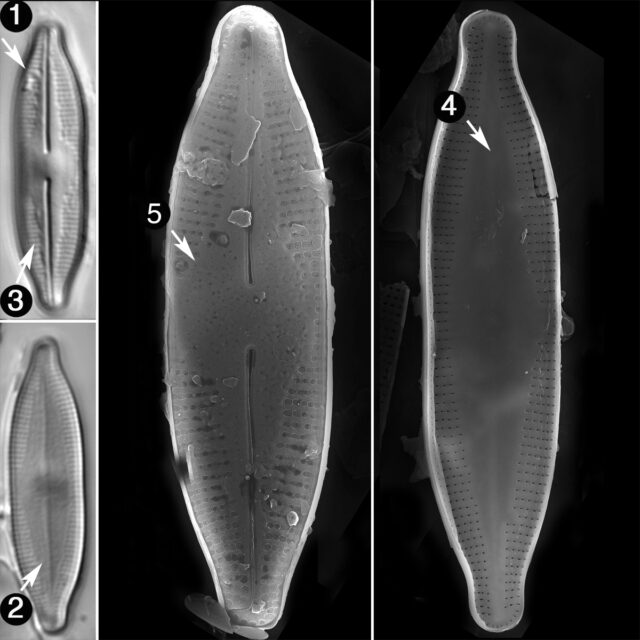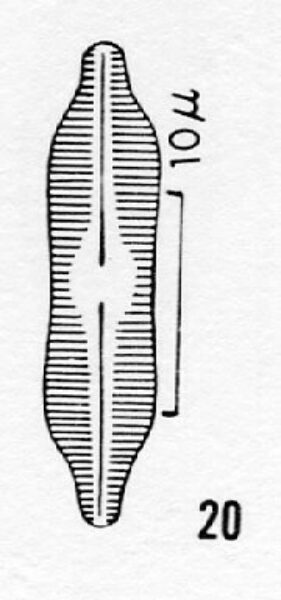Nupela pennsylvanica
-
Category
-
Length Range14-27 µm
-
Width Range4.9-5.9 µm
-
Striae in 10 µm26-30
-
SynonymsNavicula concava R.M.Patrick
-
Reported AsAchnanthes imperfecta (Schimanski 1978, pl. I: figs. 1-5)
Nupela imperfecta (Lange-Bertalot and Genkal 1999, pg.80)
-
ContributorMarina Potapova - Oct 2010
-
ReviewerSarah Spaulding - Nov 2010
Identification
View image metadata
Type
Description
Valves are linear-lanceolate with parallel or slightly constricted margins n the middle portion of the valve. Ends subrostrate. Striae are slightly radiate throughout the valve, parallel or slightly convergent at the apices, 26-30 in 10 μm. The raphe is absent on one of the valves, but the raphe slit is incompletely filled by silica and visible. Both valves have a lanceolate axial area, which on the rapheless valve is covered by reticulate siliceous thickenings. The central area on the rapheless valve is continuous with the axial area and sometimes is expanded to the margin on one side of the valve. The central area on raphe valve is circular and sometimes expanded to the valve margin on one or both sides. The raphe is almost straight; externally it lies in a shallow furrow. External proximal raphe ends are simple or slightly expanded. Internal proximal raphe slits are T-shaped.
Autecology
-
Size Range, µm3
-
Motility
-
Attachment
-
Habitat
-
Colony
-
Waterbody
-
Distribution
- Learn more about this
Original Description
Valve linear, concave in the middle portion; ends rostrate. Axial area broad, widening toward the center of the valve. Median ends of the raphe fairly distant from each other. Central area large, rounded. Striae radiate at the center of the valve, parallel or only slightly radiate at the ends. Frustules not in filaments. Striae, 26-29 in 10μ. Length, 20-23μ. Breadth at the central nodule, 4-5μ.
-
BasionymNavicula pennsylvanica
-
AuthorR.M.Patrick 1966
-
Length Range20-23 µm
-
Width4-5 µm
-
Striae in 10µm26-29
Citations & Links
Citations
-
Publication Link: 10.1080/0269249X.2011.575111
Links
Cite This Page
Potapova, M. (2010). Nupela pennsylvanica. In Diatoms of North America. Retrieved April 18, 2024, from https://diatoms.org/species/nupela_pennsylvanica
Responses
The 15 response plots show an environmental variable (x axis) against the relative abundance (y axis) of Nupela pennsylvanica from all the stream reaches where it was present. Note that the relative abundance scale is the same on each plot. Explanation of each environmental variable and units are as follows:
ELEVATION = stream reach elevation (meters)
STRAHLER = distribution plot of the Strahler Stream Order
SLOPE = stream reach gradient (degrees)
W1_HALL = an index that is a measure of streamside (riparian) human activity that ranges from 0 - 10, with a value of 0 indicating of minimal disturbance to a value of 10 indicating severe disturbance.
PHSTVL = pH measured in a sealed syringe sample (pH units)
log_COND = log concentration of specific conductivity (µS/cm)
log_PTL = log concentration of total phosphorus (µg/L)
log_NO3 = log concentration of nitrate (µeq/L)
log_DOC = log concentration of dissolved organic carbon (mg/L)
log_SIO2 = log concentration of silicon (mg/L)
log_NA = log concentration of sodium (µeq/L)
log_HCO3 = log concentration of the bicarbonate ion (µeq/L)
EMBED = percent of the stream substrate that is embedded by sand and fine sediment
log_TURBIDITY = log of turbidity, a measure of cloudiness of water, in nephelometric turbidity units (NTU).
DISTOT = an index of total human disturbance in the watershed that ranges from 1 - 100, with a value of 0 indicating of minimal disturbance to a value of 100 indicating severe disturbance.

Nupela pennsylvanica
- Valves linear-lanceolate with parallel or concave margins
- Raphe absent on one valve
- Striae 26-30 in 10 μm
- Axial areas lanceolate
- Central area on raphe valve round
Valves are linear-lanceolate with margins that are parallel or slightly constricted in the middle, with subrostrate ends. Striae are slightly radiate throughout the valve, parallel or slightly convergent at the apices, 26-30 in 10 μm. The raphe is absent on one of the valves. Both valves have lanceolate axial areas. The central area on...
 Diatoms of North America
Diatoms of North America









